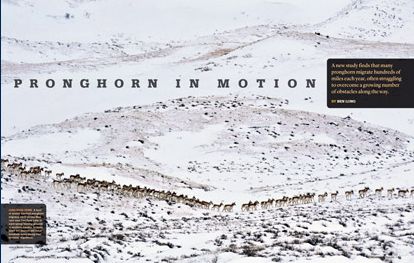Our Blog
RIVER FLY FISHING
Blackfoot River Fly Fishing
Spending a day floating through the Blackfoot River’s forested banks, half canyons, and abundant wildlife provides anglers with a stunning backdrop for a day of float fishing. Some would argue that this river is one of the most scenic in the West.
Scenery is not the only draw to the Blackfoot however. The rivers emerald green pools, boulder fields and riffles provide exceptional habitat for trout and the crystal clear water produces some exhilarating dry fly takes. Watch a few native Cutthroat trout appear from the depths to inhale your dry fly and you will understand why the Blackfoot is a favorite of many anglers.
Feisty rainbows and cutthroat dominate the fishing here, but large browns are spread throughout the system. The Blackfoot is also home to the native Bull Trout.
BLACKFOOT RIVER FLY FISHING TECHNIQUES
SPECIES GUIDES

MONTANA OUTDOORS
Pronghorn in Motion
A new study finds that many pronghorn migrate hundreds of miles each year, often struggling to overcome a growing number of obstacles along the way.
FLY FISHING THE SEASONS OF THE BLACKFOOT RIVER
Fishing the Blackfoot: Spring March – May The Blackfoot drainage is the coldest in the Missoula area and is typically the last to fish. By far the most productive spring fishing here is with nymphs and streamers. Anglers who commit to working the deep pools and riffles methodically will be rewarded. Small hatches of skwalas and blue winged olives can be found in the spring. If the right combination of water level and temperature exist, there can be excellent windows of pre-runoff dry fly fishing.
Fishing the Blackfoot: Summer June – August After runoff subsides sometime in June, depending on snow-pack, this river comes alive! Streamers readily move fish and big foam flies representing Salmonflies and Golden Stones are twitched on the surface. Good stonefly fishing lasts well into July. After the big bugs subside a smattering of Green Drakes and Pmd’s appear along with a strong hatch of Yellow Sallies. As we move into August terrestrials dominate the fishing, Hoppers and Ants are consistent producers. The Trico hatch and Spruce moth hatch can be overlooked. When the gray moths or clouds of Tricos appear the fish take notice in a big way.
Fishing the Blackfoot: Late Summer/Fall September – October September continues with excellent hopper fishing until the first couple hard freezes. Small hatches of Mahogonies and BWO’s appear as well. One of the main draws to the Blackfoot in the fall is the October Caddis hatch. Once the dry fly fishing subsides the sub surface fishing can get red hot again into the fall. The large browns become aggressive tracking down big streamers.

Facebook Comments